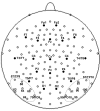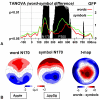Fast, visual specialization for reading in English revealed by the topography of the N170 ERP response
- PMID: 16091138
- PMCID: PMC1208852
- DOI: 10.1186/1744-9081-1-13
Fast, visual specialization for reading in English revealed by the topography of the N170 ERP response
Abstract
Background: N170 effects associated with visual words may be related to perceptual expertise effects that have been demonstrated for faces and other extensively studied classes of visual stimuli. Although face and other object expertise effects are typically bilateral or right-lateralized, the spatial topography of reading-related N170 effects are often left-lateralized, providing potential insights into the unique aspects of reading-related perceptual expertise.
Methods: Extending previous research in German, we use a high-density channel array to characterize the N170 topography for reading-related perceptual expertise in English, a language with inconsistent spelling-to-sound mapping. N170 effects related to overall reading-related expertise are defined by contrasting responses to visual words versus novel symbol strings. By contrasting each of these conditions to pseudowords, we examined how this reading-related N170 effect generalizes to well-ordered novel letter strings.
Results: A sample-by-sample permutation test computed on word versus symbol ERP topographies revealed differences during two time windows corresponding to the N170 and P300 components. Topographic centroid analysis of the word and symbol N170 demonstrated significant differences in both left-right as well as inferior-superior dimensions. Words elicited larger N170 negativities than symbols at inferior occipito-temporal channels, with the maximal effect over left inferior regions often unsampled in conventional electrode montages. Further contrasts produced inferior-superior topographic effects for the pseudoword-symbol comparison and left-lateralized topographic effects for the word-pseudoword comparison.
Conclusion: Fast specialized perception related to reading experience produces an N170 modulation detectable across different EEG systems and different languages. Characterization of such effects may be improved by sampling with greater spatial frequency recordings that sample inferior regions. Unlike in German, reading-related expertise effects in English produced only partial generalization in N170 responses to novel pseudowords. The topographic inferior-superior N170 differences may reflect general perceptual expertise for orthographic strings, as it was found for words and pseudowords across both languages. The topographic left-right N170 difference between words and pseudowords was only found in English, and may suggest that ambiguity in pronunciating novel pseudowords due to inconsistency in spelling-to-sound mapping influences early stages of letter string processing.
Figures





Similar articles
-
Left-lateralized N170 effects of visual expertise in reading: evidence from Japanese syllabic and logographic scripts.J Cogn Neurosci. 2008 Oct;20(10):1878-91. doi: 10.1162/jocn.2008.20125. J Cogn Neurosci. 2008. PMID: 18370600 Free PMC article.
-
ERP manifestations of processing printed words at different psycholinguistic levels: time course and scalp distribution.J Cogn Neurosci. 1999 May;11(3):235-60. doi: 10.1162/089892999563373. J Cogn Neurosci. 1999. PMID: 10402254
-
From orthography to phonetics: ERP measures of grapheme-to-phoneme conversion mechanisms in reading.J Cogn Neurosci. 2004 Mar;16(2):301-17. doi: 10.1162/089892904322984580. J Cogn Neurosci. 2004. PMID: 15068599 Clinical Trial.
-
Typical and Atypical Development of Visual Expertise for Print as Indexed by the Visual Word N1 (N170w): A Systematic Review.Front Neurosci. 2022 Jun 30;16:898800. doi: 10.3389/fnins.2022.898800. eCollection 2022. Front Neurosci. 2022. PMID: 35844207 Free PMC article.
-
Does physical interstimulus variance account for early electrophysiological face sensitive responses in the human brain? Ten lessons on the N170.Neuroimage. 2008 Feb 15;39(4):1959-79. doi: 10.1016/j.neuroimage.2007.10.011. Epub 2007 Oct 22. Neuroimage. 2008. PMID: 18055223 Review.
Cited by
-
Neural Specialization for English and Arabic Print in Early Readers.Neurobiol Lang (Camb). 2023 Dec 14;4(4):639-655. doi: 10.1162/nol_a_00119. eCollection 2023. Neurobiol Lang (Camb). 2023. PMID: 38213783 Free PMC article.
-
Facial and semantic emotional interference: a pilot study on the behavioral and cortical responses to the Dual Valence Association Task.Behav Brain Funct. 2011 Apr 13;7:8. doi: 10.1186/1744-9081-7-8. Behav Brain Funct. 2011. PMID: 21489277 Free PMC article.
-
Disrupted left fusiform response to print in beginning kindergartners is associated with subsequent reading.Neuroimage Clin. 2019;22:101715. doi: 10.1016/j.nicl.2019.101715. Epub 2019 Feb 12. Neuroimage Clin. 2019. PMID: 30798165 Free PMC article.
-
Spatiotemporal properties of the neural representation of conceptual content for words and pictures - an MEG study.Neuroimage. 2020 Oct 1;219:116913. doi: 10.1016/j.neuroimage.2020.116913. Epub 2020 May 7. Neuroimage. 2020. PMID: 32389730 Free PMC article.
-
Training-related changes in early visual processing of functionally illiterate adults: evidence from event-related brain potentials.BMC Neurosci. 2013 Dec 13;14:154. doi: 10.1186/1471-2202-14-154. BMC Neurosci. 2013. PMID: 24330622 Free PMC article.
References
-
- Maurer U, Brem S, Bucher K, Brandeis D. Emerging neurophysiological specialization for letter strings. J Cogn Neurosci. - PubMed
-
- Rossion B, Joyce CA, Cottrell GW, Tarr MJ. Early lateralization and orientation tuning for face, word, and object processing in the visual cortex. Neuroimage. 2003. - PubMed
LinkOut - more resources
Full Text Sources
Miscellaneous

